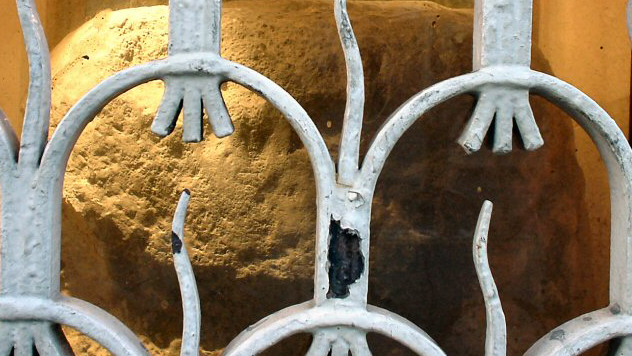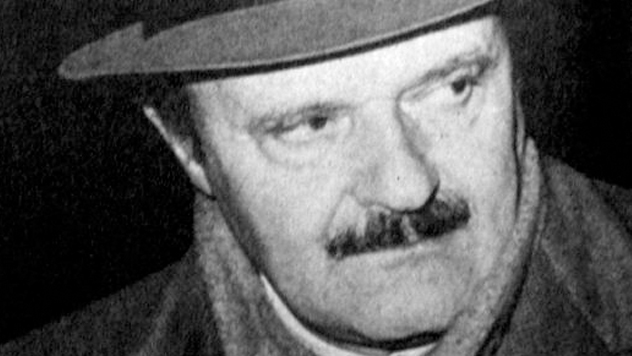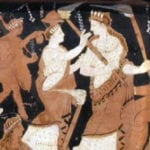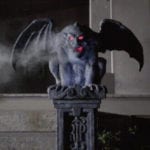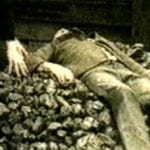10 The Murder Of Edmund Godfrey
Edmund Berry Godfrey, an English magistrate, was found dead in 1678. Though three men were convicted of his murder and hanged, many historians believe they may have been entirely innocent. The late 17th century was a time of great religious tension in England. King Charles II was on the throne but had no children. First in line was Charles’s brother James, the Duke of York. Yet Charles was Protestant, and James was Catholic. England’s Protestants weren’t keen on the idea of a Catholic taking power, so a man named Titus Oates forged a plan known as the Popish Plot. Oates claimed—falsely—to have evidence that Catholics were planning to assassinate Charles in order to bring James into power. Godfrey was dragged into the affair when Oates presented him with this “evidence.” Godfrey was a poor choice, as he had some Catholic sympathy and so failed to do much about the accusation. Yet the strain of dealing with the case caused him to have a breakdown at the start of October 1678. He disappeared on October 12 that year, reportedly a very unhappy man. Godfrey was found on October 17, strangled in a ditch. His own sword was sticking out of his back. A silversmith named Miles Prance claimed he’d witnessed Godfrey being strangled under the watch of Catholic priests—this was a claim many were happy to use to their political advantage. Prance later admitted to lying, and many had doubted him in the first place. In 1682, three men were tried for libel for suggesting that Godfrey had committed suicide. That put anyone off talking about the issue until 1685, when King Charles died and James took power. James ordered another investigation, and suicide became the official story. Subsequent historians have suggested Titus Oates and his co-conspirators may have killed Godfrey themselves. One person unrelated to the conspiracies, the Earl of Pembroke, has been suggested as a possible culprit. Pembroke was a violent aristocrat that Godfrey had convicted of murder, a conviction the House of Lords later overturned. Truly, no one knows for certain, and this one’s going to remain forever unsolved.
9 The Cheapside Hoard
On June 18, 1812, a group of laborers were demolishing a tenement building in the center of London. They were in for a surprise—a few feet below the brickwork, they found a huge collection of buried treasure. It included large amounts of jewelry crafted with gemstones from around the world, including rubies, sapphires, and emeralds. The pieces were intricate and varied—the emerald items alone included a carving of a parrot, bunches of grapes, a lizard, and a completely unique carving of a clock. In total there were 500 items, making the collection easily the most significant find of its type. Yet no one knows who it belonged to or why it was left there. The hoard has been dated to the middle of the 17th century, perhaps during the English Civil War. At that time, the area was home to a number of jewelers and goldsmiths, and it’s entirely possible one of them buried the goods for safekeeping while he went off to fight, then never made it back. Shortly afterwards, the Great Fire of London came along and destroyed everything but the cellar. The workers that found the items took them, still covered in mud and dirt, to a jewelry dealer known as Stony Jack. Jack had made it known to the laborers of London that he was more than happy to take a look at anything they dug up. He bought the pieces for a tidy sum and negotiated in secret to give them to the newly opened London Museum. The treasures continue to be shown today. The curators in charge of the collection hope that historians from around the world can help figure out where the gems came from and who was forced to leave them behind.
8 The St. Pancras Walrus
“Who is the walrus?” is no longer just a question of interest to Beatles fans. Archaeologists in London were excavating the graveyard of St. Pancras Old Church this past July, in preparation for the construction of a rail terminal. The area had been used for mass graves during the first half of the 19th century. A number of epidemics meant 44,000 bodies were buried there from 1822 to 1854, yet the contents of one coffin were particularly unusual. Scientists opened up the coffin to find the remains of eight people—and a walrus. No one knows how the sizable beast got to London. Historians think it was likely dissected by medical students, yet there are no records of such a large and exotic animal in the city at the time. Given that it would have needed to have been shipped from the Arctic, and the specimen was 4 meters (13 ft) long, it’s surprising that it didn’t make a stir. To most people around at that time, walruses were essentially sea monsters.
7 Who Owns Witanhurst Mansion?
The most modern mystery on this list involves Witanhurst Mansion, which is the second largest home in London after Buckingham Palace. While we know who owns the Queen’s residence (it’s our shape-shifting lizard overlords), no one has any idea which lucky person is in possession of number two. The 65-bedroom mansion was purchased for 50 million pounds (a little over $80 million) back in 2008. Yet the purchase was made by an offshore company, Safran Holdings, and the owners of that organization are a closely guarded secret. Whoever the owners are, they have since almost doubled the size of the building. Underground, they’re building a 20 meter (70ft) swimming pool, a spa, a cinema, and a parking lot with 24 spaces. Their expenditure on building work has cost as much as they paid for the place. One person that isn’t the owner is Russia’s richest woman, Elena Baturina. She successfully sued British newspaper the Sunday Times for libel when they suggested she was the one splashing out. Butarina claimed the “blatant lie” caused a backlash in the press in her home country. We’d like to make it absolutely clear we make no claims whatsoever as to what she may or may not have purchased with her payout from the suit.
6 The Abduction Of Elizabeth Canning
While relatively few people nowadays have heard of Elizabeth Canning, she was one of the most famous people in the whole United Kingdom back in 1753. Her tale begins on the first of January that year—Canning, who was working as a maidservant, disappeared for four weeks. Her story, and whether or not she was telling the truth, ultimately divided the nation. Canning claimed a couple of thugs had abducted her and carried her out of London to a brothel in Enfield, a town just outside the capital (which is today part of the Borough of London). The owners of the establishment had tried to force her into prostitution and locked her in an attic when she refused. They stole her corset and fed her stale bread, until she was able to escape through a window on January 29. When Canning returned to share her story, a mob led by Canning’s employer descended upon the place of her alleged imprisonment. Police soon arrested Mother Wells, the madam of the brothel, and her gypsy accomplice Mary Squires. Henry Fielding, a magistrate now famous for his novels, acquired convictions for them both. Wells was branded, and Squires was sentenced to hang for her theft of Canning’s corset. The Lord Mayor of London, Sir Crisp Gascoyne, heard about the case and thought something wasn’t right. Squires had a number of reliable alibis suggesting she was in a completely different part of England at the time of her alleged crimes. Gascoyne called on King George II to intervene, and Squires’s conviction was quashed. This angered a large swath of the public, and the entire case became a point of debate. Pamphlets on both sides of the argument were published. People wrote poems and gave talks. Even France’s Enlightenment hero Voltaire weighed in. Those against Canning suggested she’d gone into hiding to have an abortion or an illegitimate child, and concocted her abduction to avoid the shame. She was tried for and convicted of perjury, and sentenced to seven years in America. She never came back, and died in 1773. The truth of the matter has yet to be resolved, and it’s captivated many academics since. It seems impossible to be certain how much of her story is true, if any, but there doesn’t appear to be any evidence for her being anywhere else during the month she was missing.
5 The Natural History Museum Mystery Bug
London’s Natural History Museum has 28 million bugs on record, so when museum entomologist Max Barclay found one hanging around in the building’s grounds, he decided to check what it was. It turned out to be a mystery—there was no record of where the insect had come from or what it was. The creature’s closest relative was American, the box elder bug, though a similar specimen had also been found on the Mediterranean coast of France. “I was surprised to be confronted by an unidentifiable species while having a sandwich in the museum’s garden,” Barclay said. He suggested two explanations, that it may be a similar species called roeselii that’s started feasting on a different type of tree, or it might not be roeselii. We suppose two options covers all bases, at least.
4 The Beast Of Sydenham
The wildlife of England doesn’t offer much in the way of danger to its residents. The bears and wolves are long gone, and it’s much too cold for alligators. It’s perhaps no surprise, then, that sightings of large, toothy creatures create a stir. One such example is the Sydenham beast, a large black cat said to stalk the suburb from which it gets its name. The Sydenham beast was first encountered in 2005 by resident Tony Holder. In the early hours of March 22 he was out looking for his (smaller) cat, named KitKat, when he came under attack. A 1.5 meter (5 ft) long animal pounced on him, pinning him to the ground. It ran off before doing any serious damage, and Mr. Holder was treated for scratches by ambulance crew. A police team armed with tranquilizer guns scoured the area in search of the beast, but without success. While sightings of fantastical creatures are often met with understandable skepticism, the police took the issue seriously. After all, large black cats do exist. Officers made visits to schools to offer safety advice to youngsters, telling them to avoid wooded areas and dark alleyways. The police said they’d had a report of a similar creature in south London in 2002. The last reported sighting was in 2009, when a jogger claimed he’d been chased by the cat.
3 The Origin Of The London Stone
The London Stone, also known as the Stone of Brutus, is an unassuming piece of history. It’s located at 111 Cannon Street in London, behind a grate in the wall of a disused office building. You can see its resting place on Google Street View, directly underneath a “Shop To Let” sign. It’s an extremely understated home for an object that folklore deems to be necessary to London’s very survival. The stone has been in London for thousands of years. Legend says it used to form part of an altar built by Brutus the Trojan, mythical founder of the city. Poet William Blake portrayed it as a site of pagan sacrifice. Sir Christopher Wren suggested it may have been used by the Romans as the starting point for measuring distances from London, as it was located in the center of the city. It’s been mentioned by Shakespeare and Dickens. A proverb about the stone says “So long as the stone of Brutus is safe, so long shall London flourish.” It’s been moved many times, and survived disasters including the Great Fire and the Blitz. Until recently, it was under the charge of Chris Cheek, who happened to run the sports shop in 111 Cannon Street’s lower floor. The best view of the stone was from inside the shop, through a glass window just below the cricket equipment. This was arguable quite fitting because understatement and cricket are about as English as anything can be. As the To Let sign from Google Maps indicates, that shop is no longer open. The future of the stone is uncertain, and it may well be moved to a museum, at least temporarily. The building is due for demolition, so it can’t stay where it is. Chris Cheek thinks the mystery of the stone’s origin is part of its appeal, saying “If it doesn’t have a beginning, then perhaps it doesn’t have an end either.”
2 The Hanging Of Roberto Calvi
During his life, Roberto Calvi was nicknamed “God’s banker” due to his work with the Vatican. Yet he is best known for the manner of his death—he was found hanging from Blakcfriars Bridge in the heart of London on June 18, 1982. He had five bricks in his pockets, along with $14,000 worth of cash in three currencies. Leading up to his death Calvi had been accused of stealing money from the mafia, making the whole situation sound like the set-up of a crime thriller (probably starring Jason Statham). That July, a jury at an inquest declared the hanging a suicide. Not everyone was convinced, and a second inquest took place in 1983—it declared an open verdict. In 2002, a group of forensic investigators appointed by Italian judges concluded that Calvi had been murdered and hung from the bridge after his death. An American Archbishop was sought for questioning, but his position as a Vatican employee granted him immunity. Five people were put on trial in Italy in 2005, but all were acquitted in 2007. Francesco Di Carlo, a former mob boss. was linked with the killing, though he wasn’t one of the people that stood trial. Di Carlo thinks the murder will never be solved because those involved have too much power. “They are made up of a mixture of politicians, bank presidents, the military, top security. and so on,” he says. Calvi’s son continues to pursue the truth and claims to have spent nearly $25 million on lawyers and private investigators. Yet even with his efforts, the mystery won’t be solved soon, if ever.
1 The Pimlico Poisoning
On the January 1, 1886, Thomas Edwin Bartlett was found dead at his home in Pimlico in the center of London. He had been ill for some time, but when doctors performed a post-mortem, they discovered a large quantity of chloroform in his stomach and intestines. They declared this the cause of his death, and blame fell on his wife Adelaide Bartlett. There was a fair amount of circumstantial evidence against Adelaide. Her tutor (and probable lover) George Dyson confirmed that he had bought chloroform from a chemist on Adelaide’s behalf. She had admitted her intention to us the chemical to knock out her husband should he try to claim his “marital rights.” Adelaide apparently avoided sex due to her husband’s mental instability and the horrendous stink from his chronic gum disease. The case went to trial and she was acquitted. The jury believed that no convincing case had been made about how she might have been able to murder her husband. There were no burns to his throat, which would’ve been inevitable had he been forced to swallow. After the trial, famed doctor Sir James Paget said, “Now that she has been acquitted for murder and cannot be tried again, she should tell us in the interest of science how she did it!” History is silent on what became of Adelaide after the trial, and the passage of time has also failed to solve the mystery of how Thomas Bartlett met his fate. Alan’s been to London a few times and, having once paid 8 pounds for a bucket of popcorn, considers its greatest mystery to be how anyone can afford to live there. He’d love to get the chance to explore an abandoned Underground station or two.







